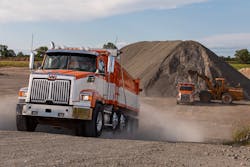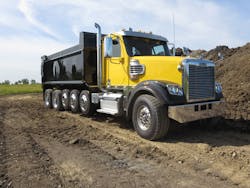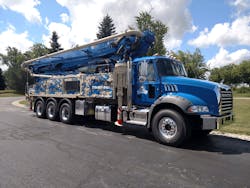Heavy Truck Makers Bounce Back in 2020
Down and out but not for long, and now they’re back. That describes truck builders and suppliers in the United States who, like much of America’s economy and society, were whacked into idleness by the coronavirus pandemic. Most of their factories had to shut down in early spring as part of a nationwide effort to contain the contagion. After roughly 30 to 60 days, they gradually reopened as health authorities and governments gained a faltering handle on the disease. It still rages, but people have learned to deal with it and industrial activity has cautiously returned. To resume production, builders have installed plastic barriers between work stations and instructed employees to wear face masks and keep prescribed distances from other workers. These are now familiar stories, but maintaining antivirus protocols requires constant and sometimes tiring vigilance.
Not many original equipment manufacturers in the United States talked in any detail about their shutdowns during the initial height of the pandemic, so numbers are not generally known. Among the few who did is Paccar of suburban Seattle.
“Paccar closed its factories for five weeks at the beginning of the quarter and has gradually resumed production while enhancing operating processes and procedures for employee health and well-being, manufacturing efficiency, and customer satisfaction,” said CEO Preston Feight in a mid-summer statement. “I am very proud of our outstanding employees who delivered excellent production and distribution performance while enhancing Paccar’s rigorous health and safety standards.” Paccar includes Kenworth Trucks, Peterbilt Motors, and Paccar Powertrain in the U.S.
Like other OEMs, Volvo Group “had to stop production for a few weeks…. We had to lay off 4,100 people globally, and North America had to take its share,” said Magnus Koeck, VP, strategy, marketing, and brand management, in a virtual press conference in July. “However, investments are still there.” Most people at Volvo Trucks’ headquarters and Uptime Center in Greensboro, North Carolina, worked from home during the shutdown: a mirror image of what was happening around the country as offices emptied and workers and their bosses continued their tasks, so America really wasn’t shut down completely, by any means. Volvo Group includes Volvo Trucks in Europe and North America, Mack Trucks, and Volvo Construction Equipment. Volvo produced some personal protective equipment for frontline healthcare workers, specifically, face shields with 3D printers.
So did its sister company, Mack Trucks, whose Lehigh Valley Operations plant in Macungie, Pennsylvania, produced hundreds of pieces of PPE, first for employees, and then donated about 500 pieces to nearby hospitals, clinics, and nursing homes, according to Rickard Lundberg, VP and general manager at the plant. Mack engineers and managers reviewed several different design possibilities before deciding upon the production of face shield headbands utilizing its 3D printer, as well as hand-crafted assembly at the plant, where all Mack Class 8 vehicles for North America and export are built. Mack planned to donate more as the PPE pieces are produced.
Autocar kept building trucks out of both its Birmingham and Hagerstown facilities “at ample build rates,” said Christopher Murray, marketing manager at Autocar Trucks. “We are very fortunate to have dedicated employees that made many adjustments to enable a safe work environment in a post-Covid world. Like many, we have experienced supply base issues downstream, which have been a challenge for us and caused some minor delays. Thankfully, we have great direct relationships with our customers who are willing to help in situations like this. They understand the situation and are able to support an adjustment in most cases.”
Construction truck 2020 production
Heavy-truck production now is at pre-virus levels, which were down somewhat from the heady heights of 2018 and 2019. Sales have come back from the cancellations made by wary truck operators amid the depths of the pandemic. Roger Nielson, CEO of Daimler Trucks North America, parent of Freightliner, Western Star, and Detroit Diesel, says its plants are cutting into order backlogs, and orders for some products stretch into next year.
“We’re building now at the same rate as before,” Nielson said during an August press conference. The industry should produce 310,000 trucks this year, he said, which is healthy but a good 100,000 fewer than those built for all of North America in 2019. Many of those built last year were replacements for 2015-model road tractors being retired from big freight-hauling fleets who trade for new trucks on a four- or five-year cycle, he said.
Though construction-truck operators don’t buy like freight haulers, many still needed vehicles to continue projects. In 2019, operators of vocational straight trucks bought about 80,000 units—a “pretty good” number—said Steve Tan of ACT Research. Two-thirds of those were construction trucks, he estimates. This year, “we expect 50,000 orders for heavy vocational trucks, down 30 percent, but they are faring better than freight hauling,” he said. “That’s an interesting story: Construction activity shut down at first, but is back pretty fast, especially for single-family housing, because people are getting away from the virus in the cities and moving into the suburbs and exurbs. But commercial construction is a disaster because there were vacancies in office buildings anyway and now with the virus no one is going to offices. Road construction is also a disaster and there’s no hope for a Highway Bill, at least before the election in November, but street building is active with the building of new neighborhoods.” One can speculate on what types of trucks and tractors are being ordered and not ordered because of cutbacks in some construction segments and activity in others.
Trailers are another story, Tan said. Lowbeds, used to haul earthmoving equipment, are down by more than 50 percent in 25- to 40-ton and over-40-ton types. Altogether, about 6,300 lowboys will be sold this year, down from about 12,000 last year. For dump trailers, ACT Research forecasts sales of 6,300 this year versus 6,700 last year, and back up to 6,700 in 2021.
“The good news is that next year we should be leaving Covid-19 behind us and things will be starting to go back to normal,” Tan said. “The downturn was not all coronavirus. We were at the end of a sugar high” from the continually growing economy which simply couldn’t last, “and the virus simply made it worse.”
As part of their march toward vertical integration, OEMs continue to develop and manufacture their own diesels and put them into large numbers of their trucks. And they are steadily putting the squeeze on Cummins, the last independent truck engine supplier in North America. An extreme example is Volvo Trucks, which says 96 percent of its trucks are sold with Volvo power. Almost all of Mack trucks use Mack diesels, with exceptions made for a medium-heavy model and now a medium-duty model that’s just entered production. Most OEMs produce their own 11- and/or 13-liter class diesels, which now make horsepower and torque more than sufficient for most hauling jobs. Because they think that the 15-liter market is eventually doomed, most OEMs have ceded that to Cummins and its X15 series. A major exception is Daimler Trucks North America, whose Detroit arm makes an engine of that size, along with a 13-liter model, but offers the X15. Several years ago, with high hopes, Cummins introduced its lightweight X12 diesel to North America, but faced a wall of resistance from OEMs who had their own engines in that size range. Building, selling, and servicing their own diesels makes a better business case for them and their dealers than using the Cummins product.
Yet Cummins is perennially reported as being the “dominant” diesel builder, with slightly over 34 percent of Class 8 sales in 2020’s first half, according to Ward’s Auto data. This is because of its X15 series, and because its 8.9-liter L9 goes into most “Baby 8” trucks. Most builders of midrange trucks turn to Cummins for power, specifically the B6.7, either using the Cummins name or under a private label, as with Paccar. Again the exception is Daimler, whose Freightliner trucks are standard with Detroit medium-duty diesels but optional with the Cummins engines. Daimler is also an exception in the Cummins X12 situation, because it offers the lightweight diesel in its Freightliner and Western Star trucks. Autocar is the only other OEM to use the X12.
Cummins continues its relevance to the market by collaborating with Eaton, the independent transmission maker, in developing good-performing Advantage powertrains (Eaton has also developed versions of its automated gearboxes with Paccar and Navistar). With the largest single market share for engines in Class 8 trucks, Cummins is likely to hang on indefinitely. It is hedging its bets, though, by moving into electric powertrains. It has a prototype running but has said little about it except at infrequent public showings. Truck operators need not hold their collective breath, but electric trucks are coming.
“The future is electric,” said Roger Nielson of Daimler Trucks in the August briefing. Daimler is putting battery-electric Freightliners into customers’ hands so they and Daimler specialists gain experience in operations and maintenance. The trucks are medium-duty eM2s and heavy eCascadias that are working in California, which has laid out a phase-in mandate. By mid-August, they had accumulated 300,000 miles among them. Volvo has put battery-electric VNR tractors to work, also in California, as part of a LIGHTS project run in partnership with state and regional local Clean Air authorities. Part of the project is erecting solar generating panels to produce the electricity used by the trucks. “Depot charging” will be necessary because utilities will simply not be able to make the power needed by an all-electric truck fleet, experts have said.
Kenworth and Peterbilt meanwhile are developing low-cab-over electric trucks, and have hydrogen fuel cell-electric trucks running as drayage tractors in some California ocean ports. Hydrogen fuel cell hybrids are seen as the alternative to all-electric trucks, especially for long-range operations. Tesla’s Elon Musk still thinks battery-electric trucks are viable for over-the-road operations. But Trevor Milton, founder of Nikola Trucks, is the primary proponent of hydrogen fuel cells, and along with truck development, he’s setting up hydrogen production stations to support his vehicles when they hit the road next year, or in 2022. Milton is not totally focused on highway tractors, as his company won a contract for at least 2,500 battery-electric trash pick-up trucks for a major refuse operation. They will be based on a cab-over-engine chassis Nikola is sourcing from Iveco, a major European truck maker, and assembled in Nikola’s new plant in southern Arizona.
If electric trucks will work for trash collection, could they work in construction, like in dump trucks? Not soon, say experts. Regeneration in stop-and-start operations will be needed and there are questions about whether dump trucks, in this example, do enough of that to make a system viable. Also, operators of construction trucks are famously conservative, and will stick with tried-and-true diesel powertrains until electric trucks are a proven commodity.


